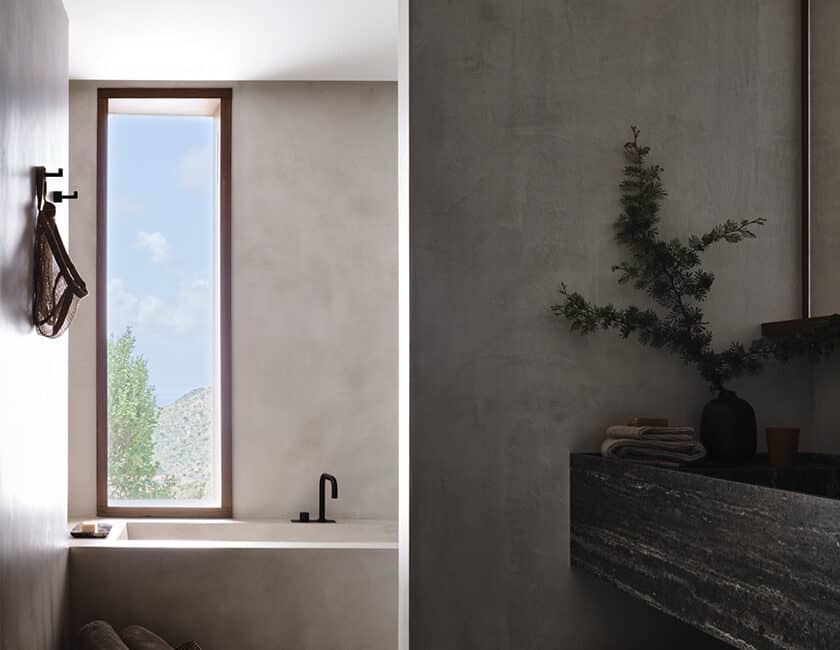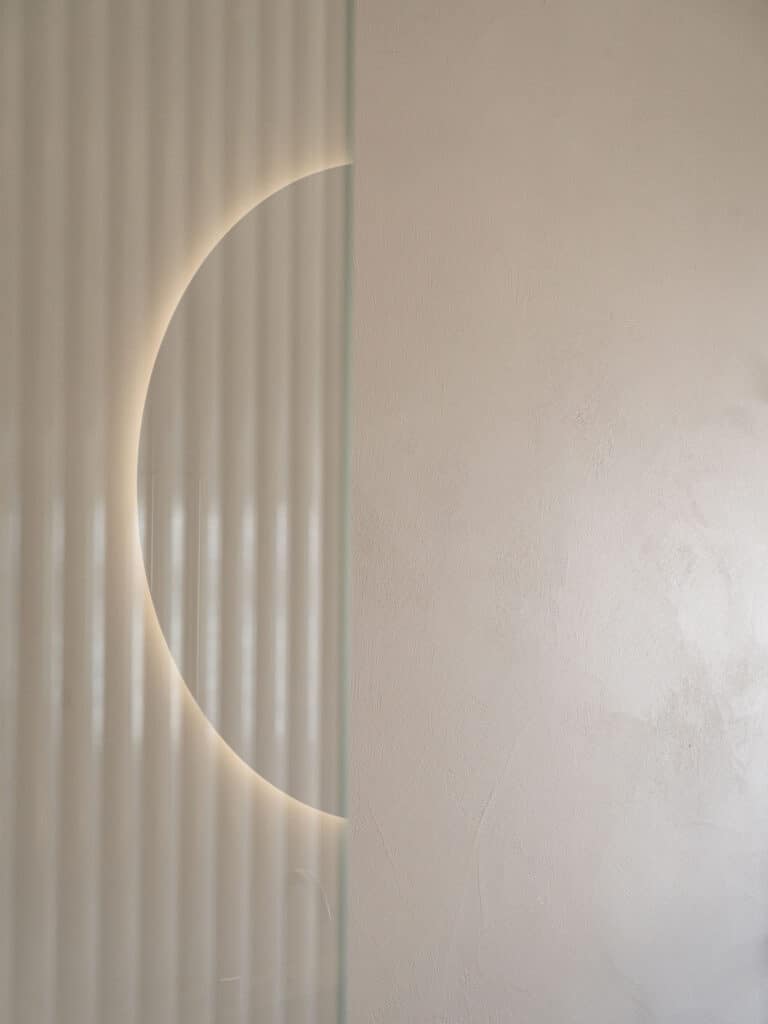Dare to use micro concrete and lime on bathroom walls

Why micro concrete is a trendy choice
The star of decorating magazines and the darling of interior designers, micro concrete on bathroom walls gives a resolutely contemporary look to wall surfaces thanks to its wealth of colors and finishes, whether matte, satin or glossy.
As part of a “total look micro concrete” design, it provides a magnificent visual continuity to the room.
Lime walls can also be installed in bathrooms, provided they are not directly exposed to water: these breathable walls carry the warmth of a thousand-year-old tradition, especially in the Mediterranean world.
Wall concrete colors and textures
Classic or bold shades
Neutral colors are the great classics in the world of waxed or varnished concrete applied to the bathroom: white, beige and light gray bring light into the everyday life of the naked body.
A rarer and bolder choice, black or charcoal gray add a touch of luxury to the room, contrasting, for example, white ceramic basins or shower trays, or light or colored lamps and sconces.
Some prefer to surround themselves with warm, Mediterranean colors, ochre, earth, terracotta, or pastels like sky blue or turquoise green.
And then there are those who dare to dare bright colors: yellow, pink, electric blue, purple…
Marius Aurenti’s extensive color chart makes it possible to combine micro concrete and lime walls in perfect color harmony.
Texture effects
Wall concrete, like lime and its variant, marmorino, can be used to create several types of texture, or even to combine them in striking contrasts or interesting harmonies:
- smooth or textured
- plain or cloudy
- matte, satin or gloss
Advantages of micro concrete bathroom walls

Durability
Extremely hard-wearing, micro concrete walls can last a long time without needing repair – although a coat of protective varnish should be applied after a few years.
Water resistance
Micro concrete is waterproof once it has been stained and/or varnished, making it ideal for wet rooms such as bathrooms.
Easy maintenance
Micro concrete walls are easy to clean and maintain, making them practical and more hygienic than tiles, whose joints tend to blacken.
Customizable
Available in a wide variety of colors and textures, micro concrete lets you customize the look of your bathroom.
Installing micro concrete on a bathroom wall
Coating
Wall-mounted concrete is not exactly the same as floor-mounted concrete: in fact, it’s a mortar coating (a mixture of cement and sand) to be laid in a thinner layer, around 2 to 3 mm thick. This is also known as smooth fine mortar.
Laying waterproof concrete
To create waterproof micro concrete, the material itself must be made water-resistant.
Water resistance begins with a watertight substrate. This is a plumber’s skill, using SEL or SPEC products. WEDI-type waterproof panels can also perform this function.
On old tiles, raking with EPXC MA’s will grip and smooth the wall, and act as a barrier.
Once this preparation is complete, the micro concrete can be laid. Thickness plays a very important role in waterproofing, and the use of 4kg/m2 of material, i.e. 2mm thick, is essential.
Marius Aurenti waterproof wall concrete is ideal for use in bathrooms.
Samples delivered directly to your home thanks to our material library.
Varnish finish
Marius Aurenti’s high-resistance varnish finish in three coats, matte, satin or gloss, will close the surface porosity of micro concrete, ensure its aesthetic role and facilitate maintenance.
Marius Aurenti, with over 15 years’ experience in the realization of these system applications, enables daily use in residential housing, as well as in public spaces(hotels and guest rooms, spas…).
Laying wall concrete over old tiles or earthenware
To lay wall concrete over old tiles or earthenware, follow these steps:
Clean tiles
Clean tiles thoroughly with soapy water to remove dirt and grease residues. Rinse and allow to dry.
Prepare the tiles
Lightly sand the tile surface with fine-grit sandpaper to improve concrete adhesion.
Apply primer
Apply Marius Aurenti primer to the tiles using a roller or brush. Allow to dry according to manufacturer’s instructions.
Mixing wall concrete
Prepare the wall concrete in the correct proportions. Make sure you obtain a homogeneous consistency.
Apply the first coat of wall concrete
Using a stainless steel float or spatula, apply a first coat of wall concrete to the tiles, making sure to cover the entire surface. Allow to dry according to manufacturer’s recommendations.
Apply the second coat of plaster
Apply a second coat of wall concrete for a smooth, even finish. Smooth with a float to create the desired effect. Allow to dry completely.
Apply a water-repellent glaze and/or varnish
Depending on product specifications, it may be necessary to apply a varnish or water-repellent protection to protect the wall concrete from moisture and facilitate maintenance.
Be sure to follow the manufacturer’s instructions and work in a well-ventilated area to ensure optimum results.
Laying concrete on plasterboard
To lay concrete mural on plasterboard, start by securing it in place:
Preparation
Dust and clean the plasterboard to remove any impurities.
Primer for drywall
Apply a suitable primer to the plasterboard, then allow to dry according to the manufacturer’s instructions.
Follow the steps described above from “Mixing wall concrete”.
Practical tips for maintaining micro concrete walls
To maintain your waxed, varnished, glazed or limewashed concrete bathroom walls, here are a few practical tips.
Varnishes and waxes are waterproof, but are polyurethane-based and therefore not designed for standing water. Therefore, be sure to :
- Do not place permanently damp objects on varnishes and waxes. For example, don’t leave a damp mop or doormat in the same place all the time.
- Keep an eye out for water leaks and prevent condensation by heating or good ventilation.
- Do not leave hygiene or beauty products (soap, shampoo, make-up remover, etc.) in permanent contact with varnish or concrete.
- Over time, renew the joints between your different materials to maintain impermeability and prevent water penetration.
- In spas or steam baths, do not expose the material to water or steam temperatures above 80°C.
- Avoid abrasive objects and products (scouring sponges, acidic or basic products) that could damage varnish or wax.
To find out more, read our maintenance guide for waxed and varnished concrete.
Conclusion
Micro concrete and lime are elegant, modern wall covering options for your bathroom.
These materials offer a variety of colors, textures and finishes, allowing you to uniquely personalize your space.
Micro concrete is particularly suitable for bathrooms, thanks to its durability, water resistance and ease of maintenance.
However, the installation of these materials can be complex and requires the help of a professional to guarantee optimum results.
By taking good care of your micro concrete or lime walls, you’ll be able to enjoy their beauty and functionality for many years to come.






